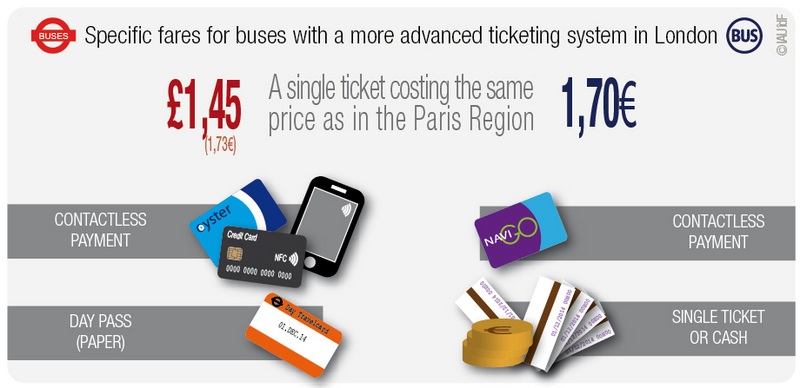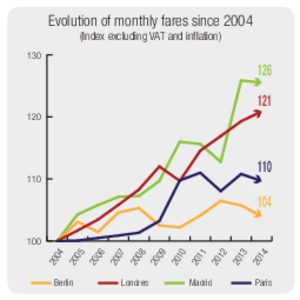Greater London vs. Paris Region: what public transport fare structure?
Following our comparison of the public transport provision in the two capital cities in a first column, let's now look at the fare policies in place in each one. At first glance, the inhabitants of the Paris Region benefit from a lower price level, but what are the actual differences?
This new column aims at reviewing the characteristics of the fare structure in place in London, with a focus on Travelcards, buses, distance and time based fares as well as the “user pays” principle.
Monthly fares two to three times more expensive in London
The comparison of public transport monthly fares reveals an important disparity between London and Paris with fares twice as high in London within the inner city (zones 1 and 2). The gap widens as more zones is included in the Travelcard, resulting in monthly fares as much as three times as expensive for the outer zones in comparison to the Paris Region (zones 7 to 9, located outside of Greater London).
Specific fares for buses, with a more advanced ticketing system in London
As we have seen in the first column, the bus network is much more developed in Greater London. For Londoners, it is also the mode that offers the most appealing fares for both its simplicity (flat rate) as well as its price point.
Independently of the route taken by bus in London or in Paris (with the t+ ticket), the price of a single trip is similar, although transfers between different routes or with a different mode (e.g.; the tube) are not allowed, while the t+ ticket in Paris allows for transfers between bus lines for up to an hour and a half (but not with the metro).
The Navigo monthly fare allows unlimited travels on all modes depending on the selected period and areas, while monthly fares in London are more varied. Greater London offers a specific bus-only all-zone monthly fare since 2002. It costs £77.60 (92,75€) and is 38% more expensive than the Navigo monthly fare for zones 1-2 (7% more expensive than the monthly fare for zones 1 to 3), and 14% cheaper than the monthly fare for zones 1 to 4.
Distance and time based fares, another characteristics of London
After launching its Oyster card, London introduced Pay-as-you-go (PAYG) in 2005. In principle, travelers can load funds on their Oyster card, as well as passes. The card is deducted depending on the distance travelled as well as the time of travel with a ceiling equal to the price of the zonal day pass (between £7 and £21.80). As of last September, the price cap also applies to the weekly pass (from £31.40 to £81.70).
With this approach, the price paid by travelers reflects their actual usage, with the underlying principle that it is more expensive to ride the subway during rush hour and on a long journey, rather than during off-peak hours for short journeys.
As a result, when using Pay as you go and traveling between zone 1 and 4, a ride on the London Underground costs 4,50€, three times the price of a single t+ ticket in Paris. However, traveling three times within the same day will cost no more than £10.60 (or £7.70 if traveling during off-peak hours).
Fares reflecting operating costs
While public transport in Paris is partly funded by employers thanks to a contribution equal to that of customers through fares (a transport tax based on payroll, which applies to both public and private sector employers), Greater London applies the user-pay principle to fund public transit. As a result, for the last ten years, the price of public transport in London has been steadily increasing beyond inflation, according to a limit set by the Chancellor or Exchequer. This resulted in a sharper disconnect between the rise in public transport prices and the cost of living in London than in Paris. These repeated fare hikes didn’t result in a decrease in ridership on the London transport network. Ridership levels have resisted and even increased since the 2008 financial crisis. Several factors may explain the level of demand: first the sustained influx of tourists and the population dynamics of London, and secondly the steady improvements made to the level and the quality of service on the network as well as the important cost of using the private car.
This page is linked to the following categories :
International
|
Mobility

